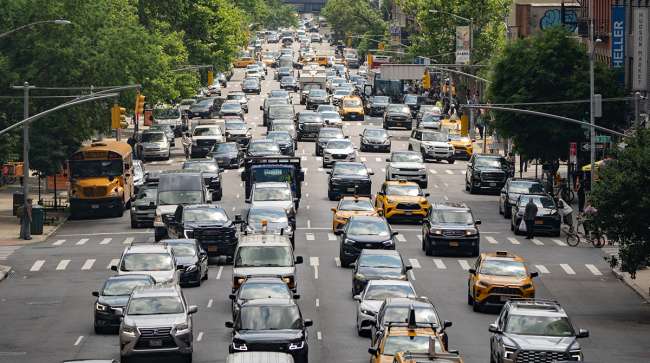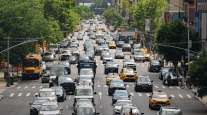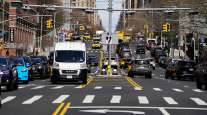Bloomberg News
NYC’s New Congestion Pricing Zone Sees 7.5% Drop in Traffic

[Stay on top of transportation news: Get TTNews in your inbox.]
Traffic on New York City’s busiest streets dropped by 7.5%, and morning travel times fell on most major crossings into Manhattan during the first work week of the city’s congestion pricing plan, signaling that some motorists changed their driving patterns to avoid the new toll.
The preliminary data from the Metropolitan Transportation Authority, which runs the city’s transit system and is implementing the toll, is the first glimpse into how the new charge is impacting commuting patterns and movement in and out of Manhattan.
The MTA on Jan. 5 started charging most motorists $9 during peak hours to drive into Manhattan’s Central Business District, which runs from 60th Street to the southern-most tip of the island. It’s the first such program in the U.S.
The early data follows a week of social media postings and reports of residents and drivers enjoying easier-flowing traffic and less vehicle honking. Prior to congestion pricing, morning traffic on the Williamsburg Bridge, which connects Manhattan and Brooklyn and serves about 92,000 vehicles a day, can extend from Manhattan streets all the way back to the bridge’s main tower in Brooklyn, according to a New York City Department of Transportation Official. This past week that line of traffic didn’t even reach the bridge’s tower on the Manhattan side, according to the official.
congestion pricing is a policy miracle pic.twitter.com/dR7ME4iSeN — sam (@sam_d_1995) January 14, 2025
“This has absolutely met our expectations,” Juliette Michaelson, the MTA’s deputy chief of policy and external relations, told reporters Jan. 13 during a briefing. “The numbers are impressive. Whether they are pedestrian, or a driver or a bus rider, everybody here has noticed a difference and that’s just really significant for the city.”
Afternoon travel times within the tolled zone declined, year over year, according to MTA data. They also dropped on Manhattan’s two major highways, the Franklin D. Roosevelt East River Drive and the West Side Highway, although southbound afternoon traffic did increase by almost three minutes on the FDR Drive. Buses are moving faster overall, especially during the morning hours and on express routes.
Along with reducing traffic, MTA officials anticipate the program will improve air quality and raise $15 billion to help modernize a more than 100-year-old transit system. MTA officials expect to release revenue-collection data in the coming weeks. Transit ridership increased last week, year over year, and the MTA anticipates a 1% boost in mass-transit usage overall because of congestion pricing.
Is congestion pricing working? Well, this stretch on Clinton Street in Brooklyn is usually filled with traffic in the morning rush. But not today. pic.twitter.com/I7yAAOI5hk — Streetsblog New York (@StreetsblogNYC) January 13, 2025
An average 539,216 vehicles drove into the tolled zone per day during the first work week of the program, Jan. 6-10, according to MTA data. That’s about 43,784 fewer vehicles on those streets, or a 7.5% decline, from an estimated 583,000 weekday baseline for January if congestion pricing weren’t in place, according to MTA data.
It took less time, on average, to travel on most major crossings that connect into Manhattan. It took 4 minutes and 27 seconds to drive through the Holland Tunnel, which links New Jersey to lower Manhattan, during Wednesday’s morning peak, according to MTA data. That’s down from an average of nearly 13 minutes during a morning commute on an average Wednesday in January 2024, according to MTA data.
MTA officials are optimistic that travel times will continue to be shorter than pre-congestion pricing levels even as traffic is expected to pick up.
Want more news? Listen to today's daily briefing above or go here for more info
“Into the spring months under ordinary circumstances without congestive pricing, you would have a growth in driving,” John McCarthy, MTA’s chief of policy and external relations, said during the briefing. “And you might see some growth compared to today, but it will be below that baseline, we believe and we hope.”
The new toll has also changed some parking habits for drivers, with neighborhoods north of 60th Street seeing an increased demand for parking in those areas. Many people who normally park between 53rd and 58th street are trying to avoid the toll, said Alex Moncayo, manager of NYC Parking 220 East 63rd Garage Corp.
“Unfortunately there is not space for all of them,” Moncayo said. “We’re packed by 9 a.m., it used to be 12 p.m. I assume I can get 30 cars per day, we’re taking 10 more cars than normal from the congestion pricing and I have to refuse the rest.”




